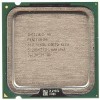Intel 640 User Guide - Page 23
System Thermal Solution Considerations
 |
UPC - 683728178901
View all Intel 640 manuals
Add to My Manuals
Save this manual to your list of manuals |
Page 23 highlights
Processor Thermal/Mechanical Information R 2.3.4 2.4 Thermal Interface Material Thermal interface material application between the processor IHS and the heatsink base is generally required to improve thermal conduction from the IHS to the heatsink. Many thermal interface materials can be pre-applied to the heatsink base prior to shipment from the heatsink supplier and allow direct heatsink attach, without the need for a separate thermal interface material dispense or attach process in the final assembly factory. All thermal interface materials should be sized and positioned on the heatsink base in a way that ensures the entire processor IHS area is covered. It is important to compensate for heatsink-toprocessor attach positional alignment when selecting the proper thermal interface material size. When pre-applied material is used, it is recommended to have a protective application tape over it. This tape must be removed prior to heatsink installation. System Thermal Solution Considerations 2.4.1 2.4.2 Chassis Thermal Design Capabilities The ATX Intel reference thermal solution assumes that the chassis delivers a maximum TA of 38 °C at the inlet of the processor fan heatsink (refer to Section 5.1.1). Improving Chassis Thermal Performance The heat generated by components within the chassis must be removed to provide an adequate operating environment for both the processor and other system components. Moving air through the chassis brings in air from the external ambient environment and transports the heat generated by the processor and other system components out of the system. The number, size, and relative position of fans and vents determine the chassis thermal performance, and the resulting ambient temperature around the processor. The size and type (passive or active) of the thermal solution and the amount of system airflow can be traded off against each other to meet specific system design constraints. Additional constraints are board layout, spacing, component placement, acoustic requirements and structural considerations that limit the thermal solution size. For more information, refer to the Performance ATX Desktop System Thermal Design Suggestions or Performance microATX Desktop System Thermal Design Suggestions documents available on the http://www.formfactors.org/ web site. In addition to passive heatsinks, fan heatsinks and system fans are other solutions that exist for cooling integrated circuit devices. For example, ducted blowers, heat pipes and liquid cooling are all capable of dissipating additional heat. Due to their varying attributes, each of these solutions may be appropriate for a particular system implementation. To develop a reliable, cost-effective thermal solution, thermal characterization and simulation should be carried out at the entire system level, accounting for the thermal requirements of each component. In addition, acoustic noise constraints may limit the size, number, placement, and types of fans that can be used in a particular design. Thermal/Mechanical Design Guide 23















